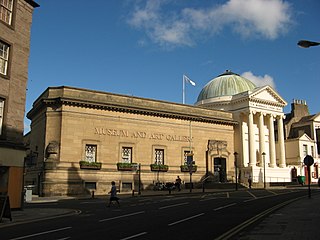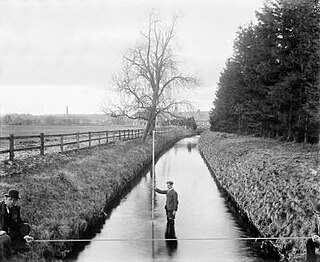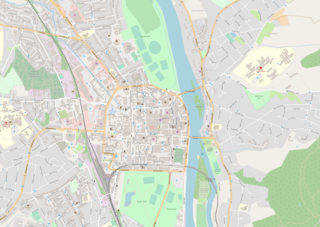
Perth is a centrally located Scottish city, on the banks of the River Tay. It is the administrative centre of Perth and Kinross council area and is the historic county town of Perthshire. It had a population of about 47,430 in 2018.

The River Tay is the longest river in Scotland and the seventh-longest in Great Britain. The Tay originates in western Scotland on the slopes of Ben Lui, then flows easterly across the Highlands, through Loch Dochart, Loch Iubhair and Loch Tay, then continues east through Strathtay, in the centre of Scotland, then southeasterly through Perth, where it becomes tidal, to its mouth at the Firth of Tay, south of Dundee. It is the largest river in the United Kingdom by measured discharge. Its catchment is approximately 2,000 square miles, the Tweed's is 1,500 sq mi (3,900 km2) and the Spey's is 1,097 sq mi (2,840 km2).

Dunkeld is a town in Perth and Kinross, Scotland. The location of a historic cathedral, it lies on the north bank of the River Tay, opposite Birnam. Dunkeld lies close to the geological Highland Boundary Fault, and is frequently described as the "Gateway to the Highlands" due to its position on the main road and rail lines north. Dunkeld has a railway station, Dunkeld & Birnam, on the Highland Main Line, and is about 25 kilometres north of Perth on what is now the A9 road. The main road formerly ran through the town, however following the modernisation of this road it now passes to the west of Dunkeld.

Perth Art Gallery is the principal art gallery and exhibition space in the city of Perth, Scotland. It is located partly in the Marshall Monument, named in memory of Thomas Hay Marshall, a former provost of Perth.

Perth Bridge is a toll-free bridge in the city of Perth, Scotland. A Category A listed structure, it spans the River Tay, connecting Perth, on the western side of the river, to Bridgend, on its eastern side, carrying both automotive and pedestrian traffic of West Bridge Street. An earlier bridge was demolished at the same location in 1621, and many unsuccessful attempts were made to replace it. A subscription was started by James VI and several noblemen to help with the construction cost, but the king's death in 1625 suspended the scheme and a series of ferryboats were instead used.

Stanley is a village on the north side of the River Tay in Perthshire, Scotland, around 6 miles north of Perth.
Perth is a city and former royal burgh in central Scotland. There has been a settlement at Perth since prehistoric times. Finds in and around Perth show that it was occupied by the Mesolithic hunter-gatherers who arrived in the area more than 8,000 years ago. Nearby Neolithic standing stones and circles followed the introduction of farming from about 4000 BC, and a remarkably well preserved Bronze Age log boat dated to around 1000 BC was found in the mudflats of the River Tay at Carpow to the east of Perth. Carpow was also the site of a Roman legionary fortress.

North Inch is a large public park in Perth, Scotland. About 57 hectares in size, it is one of two "Inches" in Perth, the other being the smaller, 31-hectare South Inch, located half a mile across the city. The inches were granted to the city, when it was a royal burgh, by King Robert II in 1374. Both inches were once islands in the River Tay; today, they are connected by Tay Street, part of the A989.

Killiechassie is a country estate and house near Weem, about one mile northeast of Aberfeldy, in Perth and Kinross, Scotland. The estate lies on the banks of the River Tay in some 12 acres, about 74 miles north of Edinburgh. It was owned by the Douglas family in the latter part of the 19th century, and a new house was erected in 1865. A dovecote by the house was listed as Grade B on 9 June 1981. The house was purchased by author J.K. Rowling in 2001.

Lady Dorothea Louisa Ruggles-Brise, was the daughter of the 7th Duke of Atholl. She was an expert in and collector of Scottish traditional music.

Perth Lade is a historic 4.5-mile (7.2 km)-long former mill lade in Perth and Kinross, Scotland. Created in the 11th century or earlier, it has been used to power several watermills, such as those that functioned at Perth's Lower City Mills, which have existed since the 18th century. Over its course, at least nineteen industrial sites existed; today, the remains of nine of these can be seen, the rest lost to inner-city development and housing schemes of the 20th and 21st centuries. A footpath follows the majority of the lade's course.

Thomas Hay Marshall was twice lord provost of Perth, Scotland. With a passion for Georgian architecture, Marshall is credited with building Perth's "new town" to the north and south of the city centre.

Parklands Hotel is a historic building in Perth, Perth and Kinross, Scotland. Located on St Leonard's Bank, it is a Category C listed building comprising two villas that have been combined into one business. When viewed from St Leonard's Bank, the villa on the left dates to the 19th century, the one on the right to the 18th century. In the early 20th century, the property was owned by London, Midland and Scottish Railway, likely due to its proximity to Perth railway station, which is about 200 feet (67 yd) to the west. It is also close to Perth bus station.

Rose Terrace is a street of Georgian architecture in the Scottish city of Perth, Perth and Kinross, dating to at least the late 18th century. It is named for Rosie Anderson, the wife of former Perth lord provost Thomas Hay Marshall, who donated the land. The couple lived at the corner of Rose Terrace and Atholl Street.
Tay Street is a street, part of the A989, in the Scottish city of Perth, Perth and Kinross. Planned in 1806 and completed around 1885, it is named for the River Tay, Scotland's longest river, on the western banks of which it sits. The street runs from the confluence of West Bridge Street and Charlotte Street in the north to a roundabout at Marshall Place and Shore Road in the south. Three of the city's four bridges that cross the Tay do so in this stretch : Perth Bridge, Queen's Bridge and the single-track Tay Viaduct, carrying Perth and Dundee trains to and from Perth railway station, located 0.5 miles (0.80 km) to the north-west.

The A989 is a road in Perth, Scotland. Also known as the Perth Inner Ring Road, due to its circumnavigation of the city centre, it is 1.93 miles (3.11 km) long. Perth's city centre is around 0.5 miles (0.80 km) long and wide. The road was constructed around 1985.

Gowrie House was a mansioun in the centre of Perth, Scotland, which existed in the 16th and 17th and 18th centuries. It was the scene of a controversial incident on 5 August 1600, and was later converted to army barracks.

Marshall Place is a prominent street in the Scottish city of Perth, Perth and Kinross. Commissioned in 1801, and today part of the A989, the Perth Inner Ring Road, it runs for about 0.23 miles (0.37 km), from a roundabout it shares with Tay Street and Shore Road in the east to a convergence with King's Place in the west.
Rosie Anderson was a figure in 18th- and 19th-century Scotland. She was the daughter of landowner Thomas Anderson, who, along with his son-in-law, Thomas Hay Marshall, was responsible for the construction of much of the Georgian architecture of Perth. Rose Terrace in Perth is now named for her.

Atholl Crescent is a historic street in the city of Perth, Scotland. Established in the late 18th century, it runs, in a crescent form, for about 315 feet (96 m), from Atholl Street in the west to Charlotte Street in the east. It overlooks the southern edge of the North Inch. Thomas Hay Marshall, twice lord provost of Perth, and substantial landowner Thomas Anderson, are credited with building Perth's Georgian "new town" to the north and south of the medieval city centre, of which Atholl Crescent and Atholl Street were the first constructions.

















